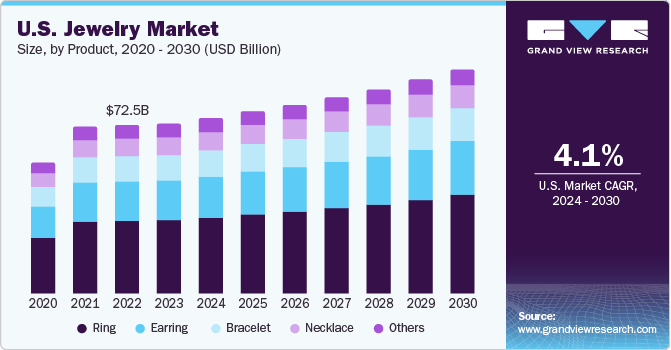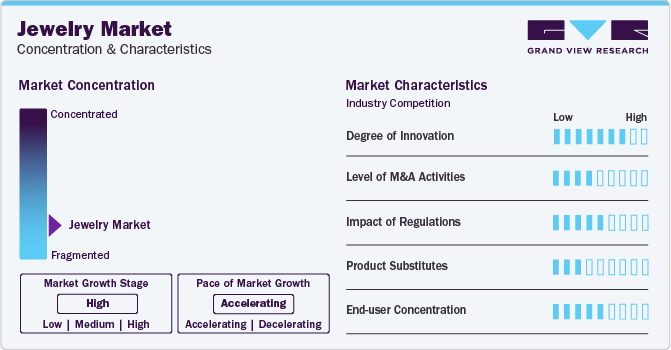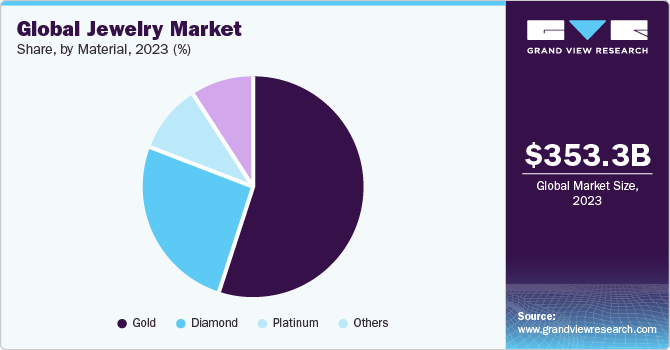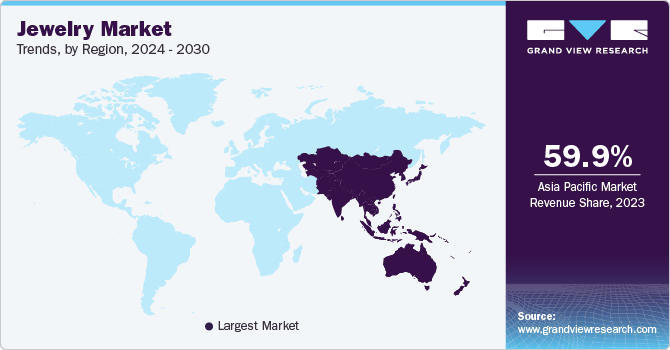- Home
- »
- Clothing, Footwear & Accessories
- »
-
Jewelry Market Size, Share, Growth & Trends Report, 2030GVR Report cover
![Jewelry Market Size, Share & Trends Report]()
Jewelry Market Size, Share & Trends Analysis Report By Product (Necklace, Ring, Earring, Bracelet), By Material (Gold, Platinum, Diamond), By Distribution Channel, By End-user (Men, Women, Children), By Region, And Segment Forecasts, 2024 - 2030
- Report ID: GVR-3-68038-106-1
- Number of Report Pages: 110
- Format: PDF, Horizon Databook
- Historical Range: 2018 - 2023
- Forecast Period: 2024 - 2030
- Industry: Consumer Goods
Jewelry Market Size & Trends
The global jewelry market size was valued at USD 353.26 billion in 2023 and is expected to grow at a compound annual growth rate (CAGR) of 4.7% from 2024 to 2030. Increasing disposable income and innovative jewelry designs offered by manufacturers are expected to drive product demand. Changing lifestyles and perceptions of jewelry as a status symbol are expected to boost the growth of this market.

The demand for gold chains and necklaces is, however, not limited only to weddings and functions. Platinum and Gold wear rings, delicate gold chains, bracelets, and anklets as fashion accessories on a daily basis. These are also gifted on various occasions such as birthdays and anniversaries. This evolving consumption behavior is expected to positively impact market growth.
The increasing acceptance of jewelry among men is also propelling the market. Products such as cufflinks, plain gold chains, tie bars, cartography necklaces, and signet rings are some of the products commonly in demand among men. Demi-fine jewelry acts as a bridge between fast fashion and high-end fine jewelry. It offers superior quality and craftsmanship compared to costume jewelry, yet remains more affordable than traditional fine pieces. Demi-fine jewelry caters to individual aesthetics, offering a wider range of designs and styles compared to traditional fine jewelry.
A vast client base makes it possible for manufacturers to cater to a large market and earn profits. The introduction of new designs and emerging fashion trends are attracting customers and manufacturers are leveraging this frequent change in fashion to design unique products to attract customers. Colored gemstones like emeralds, sapphires, and opals are stealing the spotlight, adding pops of color and individuality to jewelry collections. While classic earring and necklace sets are still popular, artificial jewelry is venturing into new territories. Hair clips, headbands, anklets, and even waist chains are gaining traction, offering even more ways to express your individual style.
Bridal jewelry also plays a significant role in driving the market. In countries like India, the high expenditure on wedding ceremonies and celebrations is expected to positively influence market growth. Gold is significant in Indian culture and is associated with festivals, customs, as well as religious beliefs. Weddings and festivals are the two main occasions for buying gold in India. According to the CAIT Research & Trade Development Society, in November 2022, India witnessed 32 lakh weddings. Bridal jewelry controls 50-55% of the market for gold jewelry.
Additionally, rising awareness about the authenticity of the metals and gems used in the jewelry pieces is driving the market. Manufacturers are not only adhering to authenticity and quality standards but also educating consumers through advertising campaigns. Beaded jewelry has a rich history and cultural significance in many parts of the world, and this is reflected in the growing popularity of ethnic-inspired pieces. Moreover, the market for men's beaded jewelry is also growing, with bracelets and necklaces becoming increasingly popular accessories.
Diamonds are becoming increasingly popular due to an increase in consumer disposable income and spending capacity. Diamonds are considered to be one of the earth’s most impressive natural materials due to their stunning attributes and are perceived as a reflection of one’s financial status. Moreover, fine jewelry is increasingly seen as an investment, with heirloom pieces passed down through generations.
The jewelry market is also expected to witness significant growth via the online channel as major players are focusing on using their websites to announce product launches, sales, and other relevant information. Online retailers often have lower overhead costs compared to physical stores, which translates to more competitive pricing for consumers. Additionally, online platforms frequently offer deals and discounts, making jewelry purchases even more appealing. However, rising e-commerce frauds and a lack of knowledge about the hallmarks of jewelry are expected to hinder market growth.
Market Concentration & Characteristics
Manufacturers are also focusing on product innovation by leveraging the demand for cross-cultural jewelry designs. Designs inspired by ethnic communities or Greek or Roman cultures are steadily penetrating the market owing to their popularity. The global market for jewelry exhibits high fragmentation, attributed to significant regional and domestic players across various countries. Leading companies employ key strategies, including mergers, expansions, acquisitions, partnerships, and product development, to enhance brand visibility among consumers.

The market is significantly influenced by regulations that govern the sourcing, production, and trade of jewelry items. Regulatory measures aimed at ensuring ethical sourcing of materials, such as gold and diamonds, and adherence to environmental standards have a notable impact on the market. Legislation concerning conflict-free sourcing, responsible mining practices, and fair labor standards directly influence the supply chain and production processes within the industry.
In the jewelry industry, various product substitutes exist that can impact consumer purchasing decisions. One notable substitute is fashion accessories such as scarves, handbags, and belts, which offer alternative ways to accessorize and complement outfits without the investment associated with fine jewelry.
Product Insights
Rings emerged as the largest segment in 2023, accounting for a revenue share of 33.8%. The rising sales of rings worldwide are principally driven by the increasing demand for wedding rings, coupled with the growing preference for corporate dressing. A key trend that has been gripping the market in recent years is the rising sale of rings within the male consumer segment. This can be attributed to improvements in men’s jewelry designs and rising fashion awareness among men around the world.
There has also been a change in the way consumers perceive rings. Younger generations with a less traditional viewpoint on marriages, tend to build a strong connection between love and rings, be it commitment rings, engagement rings, or promise rings. In the near future, jewelers are expected to increasingly target younger consumers worldwide owing to their growing affinity for rings. Collaboration with established brands and fashion designers is opening new avenues for handmade/handcrafted jewelry to gain mainstream recognition and reach a wider audience.
The earrings market is projected to progress at a CAGR of 4.5% from 2024 to 2030. Earrings are a statement and standalone piece of jewelry, they are often also worn to complement other accessories such as necklaces and bracelets. Thus, the rising demand for these jewelry items could translate into increased sales of earrings. Earrings are some of the most commonly worn pieces of jewelry owing to their simplistic designs and ease of use.
The bracelets market is projected to progress at a CAGR of 4.0% from 2024 to 2030. The rising popularity of cross-cultural designs in bracelets is among the key factors augmenting product demand around the world. In this respect, jewelry inspired by Egyptian, European, and Italian cultures is likely to gain traction in the foreseeable future.
Material Insights
The gold jewelry segment held the largest share of 54.8% in 2023, as the material is the most popular metal used in making all sorts of jewelry across the world. Gold has a cultural, emotional, and financial value for people around the world. Consumers purchasing gold are often influenced by a number of socio-cultural factors, local market conditions, and traditional practices. Consumers are looking for more than just traditional designs. Minimalist styles, geometric patterns, personalized elements, and cultural influences are gaining traction. Stackable rings, layered necklaces, and versatile pieces prepared from gold material is gaining wide scale popularity across globe.

Depending on the product type of alloy used, jewelry made with yellow, white, rose, and green gold is available in various designs and shapes. For instance, yellow gold is alloyed with silver, copper, and zinc. White gold is an alloy of gold and at least one white metal, usually nickel, silver, or palladium. Rose gold is a mixture of gold, copper, and silver, and green gold is a mixture of gold and silver, with traces of copper and other metals. The Global consensus predicts a 50% YoY rise in silver jewelry demand. The Silver Institute anticipates an 11% growth in 2022, led by India.
The diamond jewelry market is projected to grow at a CAGR of 4.6% from 2024 to 2030. Diamonds come in a variety of shapes: round, oval, cushion, princess, pear, emerald, marquise, Asscher, radiant, and heart. Their strength, durability, and efficacy make them popular among consumers and as a result, are often regarded as a valuable family heirloom. A diamond’s sparkle stems from its unique ability to refract and reflect light, which is dependent on each diamond’s proportion, symmetry, polish, and ultimate cut grade—all of which are determined during the cutting and polishing processes. While a diamond’s cut determines the stone’s overall shape, the quality of its cut determines how effectively it can reflect light.
Regional Insights
The Asia Pacific jewelry market accounted for a share of 59.9% of the global revenue in 2023. This whopping market share is mainly attributed to the high demand for jewelry from densely populated countries in the region including India and China, where gold is consumed on a large scale. Jewelry market in China is anticipated to grow at a CAGR of 5.1% from 2024 to 2030, owing to the increasing spending power of the country’s population.

The region is also present with a large number of top key players such as Malabar Golds and Diamonds, Tanishq, Queelin, Wallace Chan, and others with vast distribution networks. For instance, according to the Indian Brand Equity Foundation (IBEF), data published in July 2020, the Indian jewelry and gem sector was estimated to be one of the largest contributors to the global market and is anticipated to have 29% of the global consumption. Jewelry market growth in Singapore is driven by rising purchase of luxury jewelry through e-commerce platforms and virtual try-on experiences offer convenience and wider access to diverse brands and styles. Sustainability is becoming a major factor in the Australian jewelry market. Consumers are increasingly interested in ethically sourced materials, recycled metals, and lab-grown diamonds.
India jewelry market
The jewelry market in India is expected to grow at a CAGR of 5.7% from 2024 to 2030, as a result of factors such as the growing middle class with increased disposable incomes and changing aspirations. Traditional designs are getting a modern twist, incorporating contemporary styles and global influences. Geometric patterns, minimalist designs, and personalized elements are gaining traction. Moreover, renowned designers are partnering with jewelry brands, bringing their unique perspectives and pushing creative boundaries.
The Europe jewelry market is expected to grow at a CAGR of 4.3% from 2024 to 2030. The rising popularity of theme-based jewelry and customized designs is driving the market growth. These products are created using the latest technologies, such as 3D printing, and consumers can select from different designs and materials to make a self-designed and unique piece. In addition, the growth of e-commerce has been driving the jewelry industry in the region.
UK jewelry market
The jewelry market in the UKis projected to reach a market size of over USD 7.5 billion by 2030. The UK jewelry market is dominated by established brands and traditional craftsmanship, this segment experiences steady growth driven by high-net-worth individuals and special occasions.
U.S. jewelry market
The jewelry market in the U.S.is projected to grow at a CAGR of 4.1% from 2024 to 2030. Conscious consumers are seeking jewelry made with eco-friendly materials and sourced ethically. Recycled metals, lab-grown diamonds, and fair trade practices are becoming increasingly important. Fine jewelry with delicate designs and customizable options like birthstones and engraved messages are popular.
Key Companies & Market Share Insights
The market is characterized by the presence of a number of well-established players such as Tiffany & Co., Pandora, Chow Tai Fook, and Louis Vuitton SE, in addition to several small players and mid-sized players such as Richemont, GRAFF, Signet Jewelers Limited, H. Stern, and Malabar Gold & Diamonds. The competition in the market is intense as some of the players are among the well-known manufacturers of jewelry items and accessories. Looking to enhance their consumer base, leading players in the industry are trying to increase their presence in the Asia Pacific owing to the growing middle-class population with high disposable income. Asia presents over 50% of the global market for jewelry and is expected to showcase high growth in the luxury jewelry market segment in the coming years.
Key Jewelry Companies:
The following are the leading companies in the jewelry market. These companies collectively hold the largest market share and dictate industry trends. Financials, strategy maps & products of these jewelry companies are analyzed to map the supply network.
- Tiffany & Co
- Pandora
- Chow Tai Fook
- Louis Vuitton SE
- Richemont
- GRAFF
- Signet Jewelers Limited
- H. Stern
- Malabar Gold & Diamonds
- Swarovski AG
Recent Developments
-
In January 2023, Vrai & Oro, LLC launched the brides fine jewelry collection VRAI x Brides. The collection includes engagement rings, wedding bands, earrings, necklaces, and bracelets.
-
In October 2022, Brilliant Earth, LLC. launched its Cocktail Ring Collection. The 21-ring collection is crafted with one-of-a-kind, limited edition, lab-grown, and natural gemstones that are brightly colored and embedded in recycled precious metals
-
In October 2022, Vashi launched a 4,476 square feet store spread across two floors in Covent Garden, London. The facility, which was developed in collaboration with the New York-based creative studio Mythology, helps consumers see every step of the production process, aligning with the brand's dedication to transparency.
Jewelry Market Report Scope
Report Attribute
Details
Market size value in 2024
USD 366.79 Billion
Revenue forecast in 2030
USD 482.22 Billion
Growth Rate (Revenue)
CAGR of 4.7% from 2024 to 2030
Actuals
2018 - 2023
Forecast period
2024 - 2030
Quantitative units
Revenue in USD Million, and CAGR from 2024 to 2030
Report coverage
Revenue forecast, company ranking, competitive landscape, growth factors, and trends
Segments covered
Product, Material, Distribution Channel, End-user and Region
Regional scope
North America; Europe; Asia Pacific; Central & South America; Middle East & Africa
Country scope
U.S, Canada, Mexico, Germany, UK, Spain, Italy, France, China, India, Japan, South Korea, Australia & New Zealand, Brazil, Argentina, South Africa, UAE, Saudi Arabia
Key companies profiled
Tiffany & Co.; Pandora; Chow Tai Fook; Louis Vuitton SE; Richemont; GRAFF; Signet Jewelers Limited; H. Stern; Malabar Gold & Diamonds; Swarovski AG
Customization scope
Free report customization (equivalent up to 8 analysts working days) with purchase. Addition or alteration to country, regional & segment scope.
Pricing and purchase options
Avail customized purchase options to meet your exact research needs. Explore purchase options
Global Jewelry Market Report Segmentation
This report forecasts revenue growth at the global, regional, and country levels and provides an analysis of the latest industry trends and opportunities in each of the sub-segments from 2018 to 2030. For the purpose of this study, Grand View Research has segmented the global jewelry market report on the basis of product, material, distribution channel, end-user and region.
-
Product Outlook (Revenue, USD Million, 2018 - 2030)
-
Necklace
-
Ring
-
Earring
-
Bracelet
-
Others
-
-
Material Outlook (Revenue, USD Million, 2018 - 2030)
-
Platinum
-
Gold
-
Diamond
-
Others
-
-
Distribution Channel Outlook (Revenue, USD Million, 2018 - 2030)
-
Offline Retail Stores
-
Supermarkets & Hypermarkets
-
Jewelry stores
-
Others
-
-
Online Retail Stores
-
-
End-user Outlook (Revenue, USD Million, 2018 - 2030)
-
Men
-
Women
-
Children
-
-
Regional Outlook (Revenue, USD Million, 2018 - 2030)
-
North America
-
U.S.
-
Canada
-
Mexico
-
-
Europe
-
Germany
-
UK
-
Spain
-
Italy
-
France
-
-
Asia Pacific
-
China
-
India
-
Japan
-
South Korea
-
Australia & New Zealand
-
-
Central & South America
-
Brazil
-
Argentina
-
-
Middle East & Africa
-
South Africa
-
UAE
-
Saudi Arabia
-
-
Frequently Asked Questions About This Report
b. The global jewelry market size was estimated at USD 353.26 billion in 2023 and is expected to reach USD 366.79 billion in 2024
b. The global jewelry market is expected to grow at a compound annual growth rate of 4.7% from 2024 to 2030 to reach USD 482.22 billion by 2030.
b. Asia Pacific dominated the market for jewelry and accounted for a 59.9% share of the global revenue in 2023. This whopping market share is mainly attributed to the high demand for jewelry from densely populated countries in the region including India and China, where gold is consumed on a large scale.
b. Some of the key market players in the jewelry market are Tiffany & Co.; Pandora; Chow Tai Fook; Louis Vuitton SE; Richemont; GRAFF; Signet Jewelers Limited; H. Stern; Malabar Gold & Diamonds; Swarovski AG
b. The jewelry market has experienced significant growth in recent years, driven by Increasing disposable income and innovative jewelry designs offered by manufacturers are expected to drive product demand. Changing lifestyles and perceptions of jewelry as a status symbol.
Share this report with your colleague or friend.
![gvr icn]()
NEED A CUSTOM REPORT?
We can customize every report - free of charge - including purchasing stand-alone sections or country-level reports, as well as offer affordable discounts for start-ups & universities. Contact us now
![Certified Icon]()
We are GDPR and CCPA compliant! Your transaction & personal information is safe and secure. For more details, please read our privacy policy.
We are committed towards customer satisfaction, and quality service.
"The quality of research they have done for us has been excellent."





